Poland has a rich selection of gold and silver commemorative coins. In the year 2000 coins were launched in the series: "Animals of the World", "Castles and palaces of Poland", "Polish kings and princes" and various occasional coins.
| The Year 2000 - the turn of millenniums [1] | |||
|---|---|---|---|
| Coin designer: Ewa Tyc-Karpińska | Mint: Mennica Polska S.A. | ||
| Value: zł 200 | Alloy: outer ring: 900/1000 Au inner ring: 925/1000 Ag core: 900/1000 Au | Quantity: 6,000 pcs [1] [2] | Quality: Proof |
| Issued: 16 February 2000 [3] | Diameter:27.00 mm (1.06 in) | Weight:13.60 g (0.48 oz; 0.44 ozt) | Market value: 1.200 zł [2] |
Obverse: In the centre, a stylized image of the globe and orbits. Below, the date of issue: 2000. Above, on the left side, an image of the Eagle as the State Emblem of the Republic of Poland. On the rim the legend: RZECZPOSPOLITA POLSKA 200 ZL. Under the left talon of the Eagle, the Mint mark: m/w. Reverse: A stylized combination of fragments of: figures in the binary notation, printed circuit, DNA molecule, and elementary particles. In the inner ring, an inscription: ROK 2000 (year 2000). | |||
| The Great Jubilee of the Year 2000 [4] | |||
| Coin designer: Ewa Olszewska-Borys | Mint: Mennica Polska S.A. | ||
| Value: zł 10 | Alloy: Ag 925/1000 (Silver) | Quantity: 60,000 pcs [2] [4] | Quality: Proof |
| Issued: 8 March 2000 [3] | Diameter:32.00 mm (1.26 in) | Weight:14.14 g (0.50 oz; 0.45 ozt) | Market value: 100 zł [2] |
Obverse: In the center, an image of the Eagle as the State Emblem of the Republic of Poland against the background of a stylized rosette. Below, an inscription: 10 ZŁ. On the rim, the legend: RZECZPOSPOLITA POLSKA 2000. Under the left talon of the Eagle, the Mint mark: m/w. Reverse: Against the background of a cross, in the central part, joint Greek letters: X (chi) and P (rho) - the Christ's monogram, and A (alfa) and ω (omega) - an early Christian symbol of Jesus Christ. Between the cross's arms, symbols of Evangelists: a man and an inscription: Św. Mateusz (St. Matthew), a lion and an inscription: Św. Marek (St. Mark), a bull and an inscription: Św. Łukasz (St. Luke), and an eagle and an inscription: Św. Jan (St. John). In the rim, an inscription: WIELKI JUBILEUSZ ROKU 2000 (the Great Jubilee of the Year 2000). On the side an inscription: WIELKI JUBILEUSZ ROKU 2000 twice repeated, separated with stars (the Great Jubilee of the Year 2000). | |||
| The 1000th anniversary of the convention in Gniezno (gold 200 zł) [5] | |||
| Coin designer: Robert Kotowicz | Mint: Mennica Polska S.A. | ||
| Value: zł 200 | Alloy: Au 900/1000 (Gold) | Quantity: 1,250 pcs [2] [5] | Quality: Proof |
| Issued: 8 March 2000 [3] | Diameter:27.00 mm (1.06 in) | Weight:15.50 g (0.55 oz; 0.50 ozt) | Market value: 17,000 zł [2] |
Obverse: On the right, in a stylized oval, an image of the Eagle as the State Emblem of the Republic of Poland, and the year of issue: 2000. On the left, a stylized image of the obverse of Bolesław Chrobry's coin (denar). A semicircular inscription above: RZECZPOSPOLITA. Below, an inscription: 200 ZŁ. At the bottom, a semicircular inscription: POLSKA. Under the left talon of the Eagle, the Mint mark: m/w. Reverse: Stylized images of sitting both Bolesław Chrobry and Otto III. At the background, an ornament and elements of the Roman architecture. Above, a semicircular inscription: 1000-LECIE (1000th anniversary). At the bottom, a stylized lion on a runner. In the rim, an inscription: ZJAZDU W GNIEŹNIE (of the congress in Gniezno). | |||
| The 1000th anniversary of the convention in Gniezno (gold 100 zł) [6] | |||
| Coin designer: Robert Kotowicz | Mint: Mennica Polska S.A. | ||
| Value: zł 100 | Alloy: Au 900/1000 (Gold) | Quantity: 2,200 pcs [2] [6] | Quality: Proof |
| Issued: 8 March 2000 [3] | Diameter:21.00 mm (0.83 in) | Weight:8.00 g (0.28 oz; 0.26 ozt) | Market value: 3,300 zł [2] |
Obverse: On the right, in a stylized oval, an image of the Eagle as the State Emblem of the Republic of Poland, and the year of issue: 2000. On the left, a stylized image of the obverse of Bolesław Chrobry's coin (denar). A semicircular inscription above: RZECZPOSPOLITA. Below, an inscription: 100 ZŁ. At the bottom, a semicircular inscription: POLSKA. Under the left talon of the Eagle, the Mint mark: m/w. Reverse: Stylized images of sitting both Bolesław Chrobry and Otto III. At the background, an ornament and elements of the Roman architecture. Above, a semicircular inscription: 1000-LECIE (1000th anniversary). At the bottom, a stylized lion on a runner. In the rim, an inscription: ZJAZDU W GNIEŹNIE (of the congress in Gniezno). | |||
| The 1000th anniversary of the convention in Gniezno(silver) [7] | |||
| Coin designer: Robert Kotowicz | Mint: Mennica Polska S.A. | ||
| Value: zł 10 | Alloy: ring: 925/1000 Ag core: 925/1000 Ag oxidized | Quantity: 32,000 pcs [2] [7] | Quality: Proof |
| Issued: 8 March 2000 [3] | Diameter:32.00 mm (1.26 in) | Weight:14.14 g (0.50 oz; 0.45 ozt) | Market value: 350 zł [2] |
Obverse: On the right, in a stylized oval, an image of the Eagle as the State Emblem of the Republic of Poland, and the year of issue: 2000. On the left, a stylized image of the obverse of Bolesław Chrobry's coin (denar). A semicircular inscription above: RZECZPOSPOLITA. Below, an inscription: 10 ZŁ. At the bottom, a semicircular inscription: POLSKA. Under the left talon of the Eagle, the Mint mark: m/w. Reverse: Stylized images of sitting both Bolesław Chrobry and Otto III. At the background, an ornament and elements of the Roman architecture. Above, a semicircular inscription: 1000-LECIE (1000th anniversary). At the bottom, a stylized lion on a runner. In the rim, an inscription: ZJAZDU W GNIEŹNIE (of the congress in Gniezno). | |||
| The Animals of the World: Hoopoe [8] | |||
| Obverse designer: Ewa Tyc-Karpińska, Reverse designer: Roussanka Nowakowska | Mint: Mennica Polska S.A. | ||
| Value: zł 20 | Alloy: Ag 925/1000 (Silver) | Quantity: 24,000 pcs [2] [8] | Quality: Proof |
| Issued: 5 April 2000 [3] | Diameter:38.61 mm (1.52 in) | Weight:28.28 g (1.00 oz; 0.91 ozt) | Market value: 900 zł [2] |
Obverse: An image of the Eagle as the State Emblem of the Republic of Poland. Under the Eagle, the year of issue: 2000. Below, an inscription: ZŁ 20 ZŁ. On both sides of the Eagle's talons, an image of the State flag. Above, a semicircular inscription: RZECZPOSPOLITA POLSKA. Under the left talon of the Eagle, the Mint mark: m/w. Reverse: An image of a hoopoe sitting on a willow. At the background: a willow, a fence and a cottage. Above on the right, a semicircular inscription: Dudek - Upupa epops. | |||
| Castles and Palaces of Poland: Palace in Wilanów [9] | |||
| Obverse designer: Ewa Tyc-Karpińska, Reverse designer: Andrzej Nowakowski | Mint: Mennica Polska S.A. | ||
| Value: zł 20 | Alloy: Ag 925/1000 (Silver) | Quantity: 24,000 pcs [2] [9] | Quality: Proof |
| Issued: 17 May 2000 [3] | Diameter:38.61 mm (1.52 in) | Weight:28.28 g (1.00 oz; 0.91 ozt) | Market value: 300 zł [2] |
Obverse: An image of the Eagle as the State Emblem of the Republic of Poland, surrounded by a circle of fleur-de-lises. On both sides of the Eagle the year of issue: 20–00. On the rim, the legend: RZECZPOSPOLITA POLSKA ZŁ 20 ZŁ. Under the left talon of the Eagle, the Mint mark: m/w. Reverse: An image of the west elevation of the Wilanów palace. Below an eagle having Jan III Sobieski's coat of arms on its breast. On the left side a fragment of the gate to the palace with the figure of Polish Mars (Mars Sarmacki). A semicircular inscription above: PAŁAC W WILANOWIE (Palace in Wilanów). | |||
| Wrocław millennium (gold) [10] | |||
| Coin designer: Roussanka Nowakowska | Mint: Mennica Polska S.A. | ||
| Value: zł 200 | Alloy: Au 900/1000 (Gold) | Quantity: 2,000 pcs [2] [10] | Quality: Proof |
| Issued: 7 June 2000 [3] | Diameter:27.00 mm (1.06 in) | Weight:15.50 g (0.55 oz; 0.50 ozt) | Market value: 5.000 zł [2] |
Obverse: An image of the Eagle as the State Emblem of the Republic of Poland. Next to the right talon of the eagle the notation specifying year of issue: 2000. Around the eagle and notation specifying the year of mintage, irregular ornament of beads. Below a semi circular inscription 200 ZŁOTYCH. Above a semicircular inscription: RZECZPOSPOLITA POLSKA, separated by stars, surrounded by an irregular ornament of beads. Under the left talon of the Eagle the Mint mark: m/w. Reverse: A stylised image of Saint John the Baptist with Wrocław coat of arms. Around the image an irregular ornament of beads and an inscription: TYSIĄCLECIE WROCŁAWIA (WROCŁAW MILLENNIUM) separated by stars. In a semicircle an irregular ornament of beads. | |||
| Wrocław millennium (silver) [11] | |||
| Coin designer: Roussanka Nowakowska | Mint: Mennica Polska S.A. | ||
| Value: zł 10 | Alloy: Ag 925/1000 (Silver) | Quantity: 32,000 pcs [2] [11] | Quality: Proof |
| Issued: 7 June 2000 [3] | Diameter:32.00 mm (1.26 in) | Weight:14.14 g (0.50 oz; 0.45 ozt) | Market value: 180 zł [2] |
Obverse: On the background of a stylised image of the Town Hall in Wrocław an image of the Eagle as the State Emblem of the Republic of Poland. Over the eagle on the right side the notation specifying the year of mintage: 2000. On the left side of the eagle inscription: 10 and semicircular inscription ZŁOTYCH. Over it a semicircular description: RZECZPOSPOLITA POLSKA. Under the left talon of the Eagle the Mint mark: m/w. Reverse: Image of Wrocław coat of arms introduced into a composition of a fragment of a portal. Under it a semicircular description: TYSIĄCLECIE WROCŁAWIA (Wrocław Millennium) | |||
| The 20th Anniversary of forming the Solidarity Trade Union (gold) [12] | |||
| Coin designer: Robert Kotowicz | Mint: Mennica Polska S.A. | ||
| Value: zł 200 | Alloy: Au 900/1000 (Gold) | Quantity: 2,500 pcs [2] [12] | Quality: Proof |
| Issued: 23 August 2000 [3] | Diameter:32.00 mm (1.26 in) | Weight:23.32 g (0.82 oz; 0.75 ozt) | Market value: 8.500zł [2] |
Obverse: An image of the Eagle as the State Emblem of the Republic of Poland, on both sides of the Eagle the year of issue: 20–00. Under the Eagle an inscription: ZŁ 200 ZŁ, on the rim a semicircular description: RZECZPOSPOLITA POLSKA. Under the left talon of the Eagle, the Mint mark: m/w. Reverse: On the right side images of two children, on the left side inscription SOLIDARNOŚĆ, made in red and white enamel and inscription 1980–2000. In the background an image of a fragment of the globe with stylised geographical grid and a fragment of the outline of Europe | |||
| The 20th Anniversary of forming the Solidarity Trade Union (silver) [13] | |||
| Obverse designer: Ewa Tyc-Karpińska, Reverse designer: Robert Kotowicz | Mint: Mennica Polska S.A. | ||
| Value: zł 10 | Alloy: Ag 900/1000 (Silver) | Quantity: 40,000 pcs [2] [13] | Quality: Proof |
| Issued: 23 August 2000 [3] | Diameter:32.00 mm (1.26 in) | Weight:14.14 g (0.50 oz; 0.45 ozt) | Market value: 200 zł [2] |
Obverse: An image of the Eagle as the State Emblem of the Republic of Poland, on both sides of the Eagle the year of issue: 20–00, under the Eagle a description: ZŁ 10 ZŁ, on the rim a semicircular description: RZECZPOSPOLITA POLSKA, preceded and followed by five beads. Under the left talon of the Eagle, the Mint mark: m/w. Reverse: On the right side images of two children, on the left Polish flag, made in red and white enamel and inscription SOLIDARNOŚĆ / 1980–2000. In the background an image of a fragment of the globe with stylised geographical grid and a fragment of the outline of Europe. | |||
| Polish Kings and Princes: Queen Jadwiga (1384–1399) [14] | |||
| Obverse designer: Ewa Tyc-Karpińska, Reverse designer: Stanisława Wątróbska-Frindt | Mint: Mennica Polska S.A. | ||
| Value: zł 100 | Alloy: Au 900/1000 (Gold) | Quantity: 2,000 pcs [2] [14] | Quality: Proof |
| Issued: 6 September 2000 [3] | Diameter:21.00 mm (0.83 in) | Weight:8.00 g (0.28 oz; 0.26 ozt) | Market value: 3.800zł [2] |
Obverse: Image of the Eagle as the State Emblem of the Republic of Poland, on its sides the notation specifying the year of mintage: 20–00, under the Eagle description: ZŁ 100 ZŁ, in the rim an inscription: RZECZPOSPOLITA POLSKA. Under the left talon of the Eagle the Mint mark: m/w. Reverse: A bust of the Queen Jadwiga based on the drawing by Jan Matejko, above a semicircular inscription JADWIGA 1384–1399. | |||
| Polish Kings and Princes: Jan II Kazimierz(1648–1668) [15] | |||
| Coin designer: Ewa Tyc-Karpińska | Mint: Mennica Polska S.A. | ||
| Value: zł 100 | Alloy: Au 900/1000 (Gold) | Quantity: 2,000 pcs [2] [15] | Quality: Proof |
| Issued: 27 September 2000 [3] | Diameter:21.00 mm (0.83 in) | Weight:8.00 g (0.28 oz; 0.26 ozt) | Market value: 3.500zł [2] |
Obverse: Image of the Eagle as the State Emblem of the Republic of Poland, on its sides the notation specifying the year of mintage: 20–00, under the eagle description: ZŁ 100 ZŁ, on the rim an inscription: RZECZPOSPOLITA POLSKA. Under the left talon of the Eagle the Mint mark: m/w. Reverse: Bust of the King Jan II Kazimierz. On the left side a diagonal inscription Jan II Kazimierz / 1648–1668. | |||
| Polish kings and princes: Jan II Kazimierz (bust) [16] | |||
| Coin designer: Ewa Tyc-Karpińska | Mint: Mennica Polska S.A. | ||
| Value: zł 10 | Alloy: Ag 925/1000 (Silver) | Quantity: 20,000 pcs [2] [16] | Quality: Proof |
| Issued: 27 September 2000 [3] | Diameter:32.00 mm (1.26 in) | Weight:14.14 g (0.50 oz; 0.45 ozt) | Market value: 300 zł [2] |
Obverse: Image of the Eagle as the State Emblem of the Republic of Poland, on its sides the notation specifying the year of mintage: 20–00, under the Eagle description: ZŁ 10 ZŁ, on the rim an inscription: RZECZPOSPOLITA POLSKA, preceded and followed by five beads. Under the left talon of the Eagle the Mint mark: m/w. Reverse: Bust of the King Jan II Kazimierz. On the left side a semicircular inscription Jan II Kazimierz 1648–1668. | |||
| Polish kings and princes: Jan II Kazimierz (torso) [17] | |||
| Coin designer: Ewa Tyc-Karpińska | Mint: Mennica Polska S.A. | ||
| Value: zł 10 | Alloy: Ag 925/1000 (Silver) | Quantity: 14,000 pcs [2] [17] | Quality: Proof |
| Issued: 27 September 2000 [3] | Diameter:32.00 mm (1.26 in) | Weight:14.14 g (0.50 oz; 0.45 ozt) | Market value: 550 zł [2] |
Obverse: Image of the Eagle as the State Emblem of the Republic of Poland, on its sides the notation specifying the year of mintage: 20–00, under the Eagle description: ZŁ 10 ZŁ, on the rim an inscription: RZECZPOSPOLITA POLSKA, preceded and followed by five beads. Under the left talon of the Eagle the Mint mark: m/w. Reverse: Half figure of the King Jan II Kazimierz. On the sides of the image dates: 1648, 1668. Below a semicircular inscription: Jan II Kazimierz. | |||
| Polish Museum in Rapperswil - 130th Anniversary of Foundation [18] | |||
| Coin designer: Ewa Olszewska-Borys | Mint: Mennica Polska S.A. | ||
| Value: zł 10 | Alloy: Ag 925/1000 (Silver) | Quantity: 25,000 pcs [2] [18] | Quality: Proof |
| Issued: 18 October 2000 [3] | Diameter:32.00 mm (1.26 in) | Weight:14.14 g (0.50 oz; 0.45 ozt) | Market value: 130 zł [2] |
Obverse: Image of the Eagle as the State Emblem of the Republic of Poland, under the Eagle description: ZŁ 10 ZŁ. On the left side a stylised image of a fragment of Rapperswil Castle, on the right side a stylised image of a fragment of the Royal Castle in Warsaw. Above an inscription: RZECZPOSPOLITA / POLSKA / ROK 2000 (Year 2000). Under the left talon of the Eagle the Mint mark: m/w. Reverse: A stylised image of a fragment of Bar Column: a fragment of shaft, capital, sphere and eagle. On the left side inscription: MAGNA / RES / LIBERTAS and semicircular inscription: MUZEUM POLSKIE (Polish Museum). On the right side inscription: 1870 / 2000 and semicircular inscription: W RAPPERSWILU (in Rapperswil). | |||
| 30th Anniversary of the December Events in 1970 [19] | |||
| Coin designer: Ewa Tyc-Karpińska | Mint: Mennica Polska S.A. | ||
| Value: zł 10 | Alloy: Ag 925/1000 oxidized (Oxidized Silver) | Quantity: 37,000 pcs [2] [19] | Quality: Proof |
| Issued: 16 November 2000 [3] | Diameter:32.00 mm (1.26 in) | Weight:14.14 g (0.50 oz; 0.45 ozt) | Market value: 120 zł [2] |
Obverse: On the left side an image of the Eagle as the State Emblem of the Republic of Poland. Centrally, uneven pavement with a stylised image of the emblem of the Republic of Poland on it. Below an inscription: 10 zł. Beneath, a semicircular description: Rzeczpospolita Polska, below the year of emission: 2000. Under the left talon of the Eagle, the Mint mark: m/w. Reverse: Centrally, pavement with stylised figures of people on it. Above, an inscription: 30. rocznica / ' 70 (30th Anniversary / of December ' 70). On the side an inscription: GDAŃSK GDYNIA SZCZECIN ELBLĄG SŁUPSK separated with asterisks. | |||
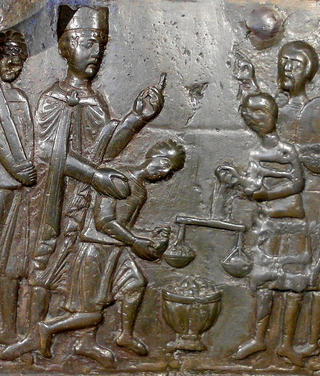
Bolesław I the Brave, less often known as Bolesław the Great, was Duke of Poland from 992 to 1025, and the first King of Poland in 1025. He was also Duke of Bohemia between 1003 and 1004 as Boleslaus IV. A member of the ancient Piast dynasty, Bolesław was a capable monarch and a strong mediator in Central European affairs. He continued to proselytise Western Christianity among his subjects and raised Poland to the rank of a kingdom, thus becoming the first Polish ruler to hold the title of rex, Latin for king.
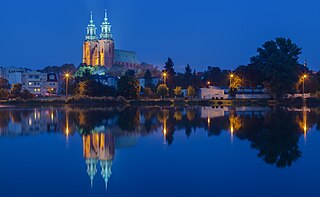
Gniezno is a city in central-western Poland, about 50 kilometres east of Poznań. Its population in 2021 was 66,769, making it the sixth-largest city in the Greater Poland Voivodeship. One of the Piast dynasty's chief cities, it was the first historical capital of Poland in the 10th century and early 11th century, and it was mentioned in 10th-century sources, possibly including the Dagome Iudex, as the capital of Piast Poland. Gniezno is the seat of the Roman Catholic Archdiocese of Gniezno, the country's oldest archdiocese, founded in 1000, and its archbishop is the primate of Poland, making the city the country's ecclesiastical capital. The city is the administrative seat of Gniezno County (powiat).

The złoty is the official currency and legal tender of Poland. It is subdivided into 100 grosz (gr). It is the most traded currency in Central and Eastern Europe and ranks 21st most-traded in the foreign exchange market.
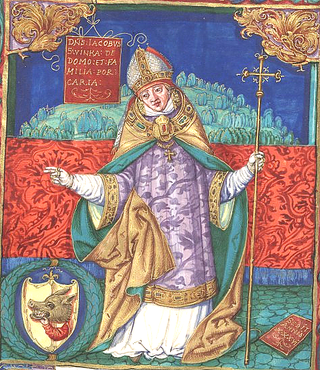
Jakub Świnka was a Polish Catholic priest, the Archbishop of Gniezno and a notable politician, supporter of the idea of unification of all Polish lands under the rule of Władysław I the Elbow-high. His coat of arms was Świnka.
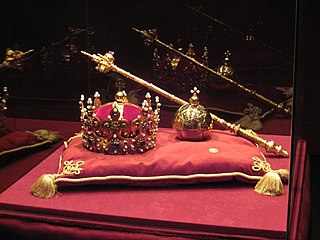
The only surviving original piece of the Polish crown jewels from the time of the Piast dynasty is the ceremonial sword – Szczerbiec. It is currently on display along with other preserved royal items at the Wawel Royal Castle Museum in Kraków.
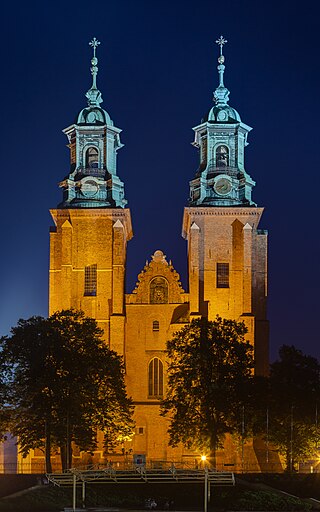
The Archdiocese of Gniezno is the oldest Latin Catholic archdiocese in Poland, located in the city of Gniezno. The ecclesiastical province comprises the suffragan dioceses of Bydgoszcz and Włocławek.
The Czech National Bank issues 200 / 500 Koruna (Kč) silver commemorative coins and golden commemorative coins of various denominations. The golden coins are issued in thematic sets – Bohemian crown set, Charles IV set, Ten centuries of architecture set, Industrial Heritage Sites set and Bridges in the Czech Republic set. In 1999 the special 2000 Kč silver coin with golden inlay and hologram was issued. In 2019, to commemorate the 100th anniversary of Czechoslovak koruna, a heavyweight gold coin weighing 130 kg was issued as well as a commemorative one-hundred crown banknote.

Józef Jan Gosławski was a Polish sculptor and medallic artist. He was a designer of coins, monuments and medals. Laureate of many artistic competitions; decorated with the Silver Cross of Merit.

The 10 Polish Złotych note is the lowest value złoty banknote and has been used since the redenomination of the złoty in 1995. The note is used as the sole currency in Poland, a country with a population of about 38 million.

The 20 Polish Złotych note is a denomination of the Polish złoty.
Poland has a rich selection of Gold and Silver commemorative coins. In the year 2008 coins were launched in the series: "Animals of the World", "Monuments of Material Culture in Poland", "Polish Painters of the Turn of 19th and 20th Centuries", "The Polish Calendar of Traditional Customs and Rituals", "History of the Polish Zloty", and various occasional coins.
Poland has a selection of gold and silver commemorative coins. In the year 1998 coins were launched in the series: "Polish Kings and Princes", "Castles and Palaces of Poland", "The Animals of the World" and various occasional coins.
Poland has a rich selection of Gold and Silver commemorative coins. In the year 1999 coins were launched in the series: "Polish Travelers and Explorers", "Animals of the World", "Polish kings and princes", "Castles and palaces of Poland" and various occasional coins.
Poland has a rich selection of Gold and Silver commemorative coins. In the year 2006 coins were launched in the series: "Animals of the World", "History of the Polish Złoty", "The Polish Calendar of Traditional Customs and Rituals", "Monuments of Material Culture in Poland" ,"History of the Polish Cavalry", "Polish Painters of the Turn of 19th and 20th Centuries" and various occasional coins.
Poland has a rich selection of gold and silver commemorative coins. In the year 2001 coins were launched in the series: "Monuments of Material Culture in Poland", "Polish kings and princes", "The Animals of the World", "Polish Travelers and Explorers", "The Polish Calendar of Traditional Customs and Rituals" and various occasional coins.
Poland has a rich selection of gold and silver commemorative coins. In 2002 coins were launched in the series: "Polish kings and princes", "The Animals of the World", "Polish Travelers and Explorers", "Monuments of Material Culture in Poland", "Polish Painters of the Turn of 19th & 20th Centuries" and various occasional coins.
Poland has a rich selection of gold and silver commemorative coins. In the year 2005 coins were launched in the series: "Polish Kings and Princes", "Animals of the World", "History of the Polish Zloty" and "Polish Painters of the Turn of 19th and 20th Centuries" and various occasional coins.

The architecture of Poland includes modern and historical monuments of architectural and historical importance.
The Museum of John Paul II and Primate Wyszyński is a Roman Catholic cultural and educational institution affiliated with the Archdiocese of Warsaw, honoring two prominent Polish Catholic leaders: Saint John Paul II, the first Polish Pope, and Cardinal Stefan Wyszyński, the Archbishop of Warsaw and Gniezno and Primate of Poland. It was established by a decree of 18 May 2010 issued by Archbishop Kazimierz Nycz.

The Millennium of the Polish State was a national celebration of the Christianization of Poland and the subsequent establishment of the first Polish nation. The celebrations took place over the years 1960–1966 by a resolution of the Sejm in 1958. The inauguration of the jubilee celebrations took place at the plenary session of the National Committee of the Unity Front on 16 February 1960 in Kalisz. The jubilee celebrations were accompanied by the educational program One thousand schools for the 1000th anniversary during which in the years 1959–1972 nearly 1.5 thousand schools were built. It was decided to use the anniversary by both the hierarchy of the Catholic Church and the Polish United Workers' Party for the propaganda in Poland. The church planned the celebration of the millennium of the baptism of Poland while the state authorities strictly commemorated the jubilee of the beginnings of the Polish nation.